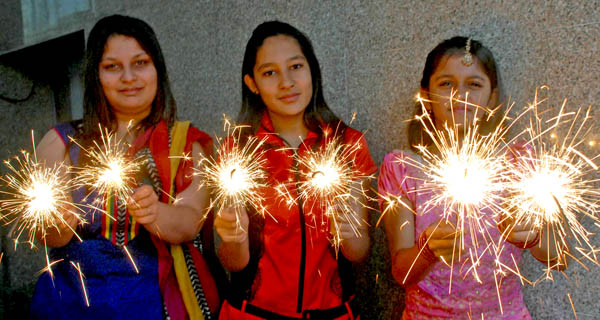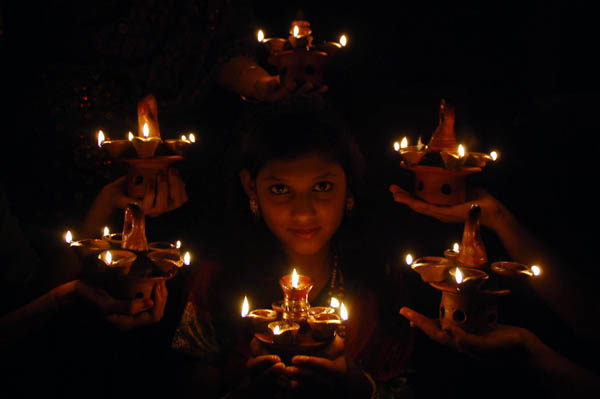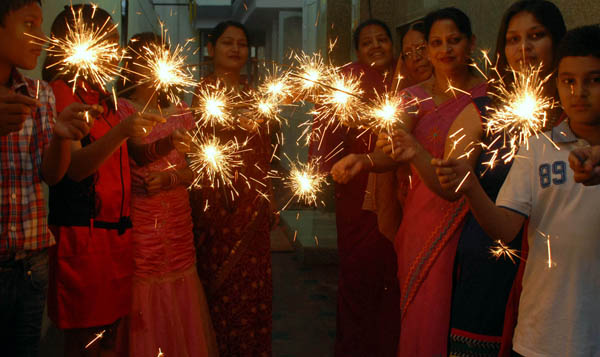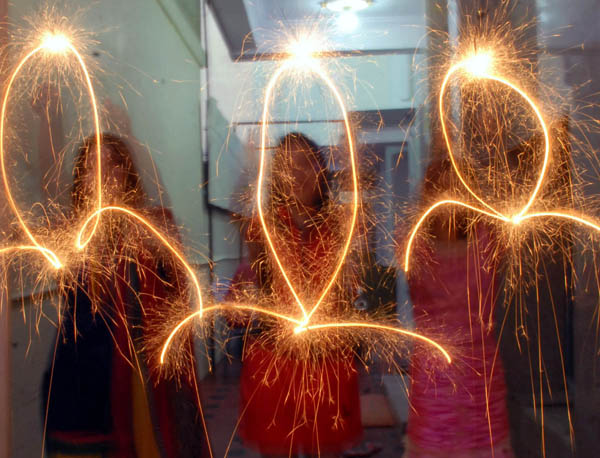
Diwali is popularly known as the Festival of lights and is one of the biggest festivals. It’s a five day festival occurring in late Ashvayuja maasa and ends in early Kartika. It is celebrated with great enthusiasm and vigour all around India by Hindus, Jains and Sikhs.
Many significant events are associated for the origin of diwali being, return of Lord Rama from exile to Ayodhya; Lord Krishna’s elimination of Narakasura; Lord Krishna lifting up Mount Govardhana.
On day 1 i.e. Dhanatrayodashi, homes and offices are renovated and decorated, to welcome the Goddess of wealth and prosperity. To symbolize her arrival, small footprints are drawn with rice flour and vermilion powder all over the house. Lamps are kept burning all through the night. "Lakshmi-Puja" is performed in the evening, with tiny diyas of clay lit to drive away the shadows of evil spirits.
A very interesting story about this day is of the sixteen year old son of King Hima. Astrologers predicted he would die by a snake-bite on the fourth day of his marriage. On that day, his young wife did not allow him to sleep. She laid out an array of ornaments and piles of gold and silver coins at the entrance of her husband's bedroom and lit lamps all over the house. And she spent the night, telling stories and singing songs. When Yama, the god of Death, arrived in the guise of a serpent, his eyes were blinded by the dazzle and he could not enter the Prince's chamber. So he climbed on top of the heap of ornaments and coins and spent the night listening to her melodious songs. In the morning he quietly slipped away.
Since then, lamps are kept burning throughout the night on Diwali in reverential adoration to Yama.
The significance of day 2, popularly known as Naraka Chaturdasi, is the slaying of the demon king Narakasura. He had defeated the king of Gods, Lord Indra and snatched away the magnificent earrings of Aditi, the Mother Goddess and imprisoned sixteen thousand daughters of the gods and saints in his harem. Lord Krishna killed the demon and liberated the imprisoned damsels and also recovered Aditi's precious earrings. Lord Krishna then smeared his forehead with the demon king's blood, and returned home where womenfolk massaged scented oil into his body and gave him a bath to wash away the filth from his body.
Since then the custom of taking a bath before sunrise on this day has become a traditional part of Diwali day. After the puja, children burst firecrackers heralding the defeat of the demon. As this is a day of rejoicing, many will have very elaborate breakfasts and lunches and meet family and friends.
Day 3 is the Lakshmi Puja - This most important part of Diwali celebrations is entirely devoted to the propitiation of Goddess Lakshmi (Goddess of Wealth). On this day Lakshmi strolls amidst her devotees, showering her blessings of plenty and prosperity among them.
A strange story lies behind the practice of gambling on this day. Goddess Parvati played dice with her husband, Lord Shiva. She decreed that whosoever gambled on Diwali night would prosper throughout the ensuring year!
Day 4 - Balipadya or Govardhan Puja - The people of Lord Krishna's home town, Gokul, worshipped Lord Indra at the end of every monsoon season. One year, the young Krishna stopped them, insisting they pray to Mount Govardhan instead. Furious, Lord Indra sent a terrible rainstorm to submerge Gokul. It lasted for weeks. But Krishna saved his Gokul and protected his people by holding up Mt.Govardhan on his little finger, shielding them with it like an umbrella.
The day commemorates the victory of Vishnu in his dwarf form Vamana over the demon-king Bali, who was pushed to the nether-world, and the return of Bali to earth from the nether-world.
Day 5 is Bhayya Duj - Yama, the God of Death, visited his sister Yami on this day. She anointed his forehead with the auspicious 'tilak', garlanded him and delighted him with special sweets and dishes. They enjoyed a wonderful day in each other's company, and while parting Yama gave her a special gift as a token of his love. Yama announced that anyone who receives tilak from his sister will never be thrown.
Since then the fifth day of Diwali is celebrated as a symbol of love between sisters and brothers.
People decorate their home and temples by drawing rangoli patterns. Hindus believe that Goddess Laxmi will see these and visit their homes.
Diwali being festival of lights, across India people celebrate it via symbolic diyas and colourful paper lanterns, which are an integral part of Diwali decorations.
Diwali is celebrated around the world especially places where there large populations of Hindu and Indian origin. These countries are Australia, Canada, Fiji, Guyana, Surinam, Indonesia, Japan, Kenya, Malaysia, Mauritius, Myanmar, Nepal, New Zealand, Singapore, South Africa, Sri Lanka, Tanzania, Trinidad and Tobago, Thailand, the United Kingdom and the United States.
In Nepal, Diwali is known as "Tihar" or "Swanti". In Trinidad and Tobago, communities all over the islands get together and celebrate the festival. In Malaysia, Diwali is known as "Hari Deepavali," and it is a national holiday throughout Malaysia. In Singapore, the festival is called "Deepavali", and is a public holiday. In Britain and United States, Hindus and Sikhs celebrate Diwali with great enthusiasm and in most ways very similarly to as in India.
A festival of light and beauty, Diwali encourages artistic expression and builds a strong sense of community. The diverse cultures and customs of India mingle together in a wonderful celebration of joy, light and unity. Wish all the readers a Happy Diwali.













Comments
Add new comment